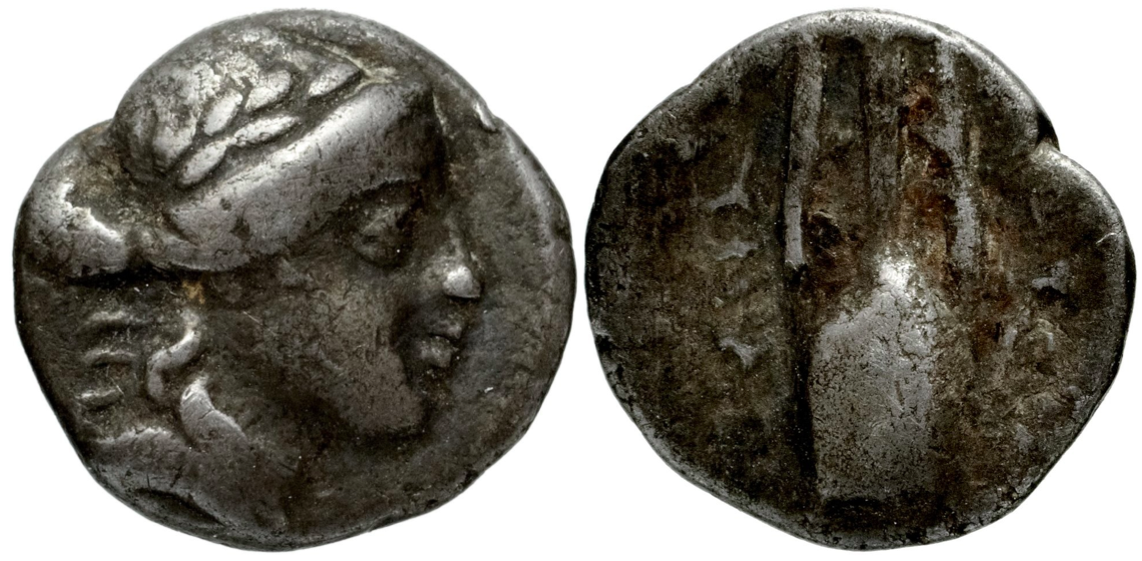Cos, silver, hemidrachms (Apollo/cithara) (180-170 BCE)
From SILVER
180 BCE - 170 BCE Silver 1,117 kg
Description
| ObverseInscription or printing placed on the obverse.: | Head of Apollo right, wearing laurel wreath. |
| ReverseInscription or printing placed on the reverse.: | ΚΩΙΟΝ (Greek).Cithara. In the field, magistrate name and letter. |
Mint and issuing power
| MintIdentifies the place of manufacture or issue of a numismatic object.: | Cos | Ancient regionAncient region.: | Caria (islands) | Modern countryModern country: Greece | AuthorityIdentifies the issuing power. The authority can be "pretended" when the name or the portrait of X is on the coin but he/she was not the issuing power. It can also be "uncertain" when there is no mention of X on the coin but he/she was the issuing power according to the historical sources: |
Chronology
| FromIdentifies the initial date in a range assigned in a numismatic context. | 180 BCE | toIdentifies the final date in a range assigned in a numismatic context.. | 170 BCE | PeriodTime period of the numismatic object.: Hellenistic 323-30 BC |
Physical description
| MetalThe physical material (usually metal) from which an object is made.: | Silver |
Median weightMedian of the weights of numismatic objects (in grams). in grams | 1.50 | DenominationTerm indicating the value of a numismatic object. Examples: tetradrachm, chalkous, denarius.: | hemidrachm |
StandardStandard.: |
Image

RQEM_ad_297.png "Paris, BnF, Fonds général 1234 (https" has not been listed as valid URI scheme.[Paris, BnF, Fonds général 1234 (https://gallica.bnf.fr/ark:/12148/btv1b8523260r)]
References
| Die study referencePublication of the study: | Ingvaldsen 20021Ingvaldsen 2002, p. 366-368 (series XXIV) | ||
| Coin series referenceReference to coin series study: | |||
| Coin series web referenceCoin series web references: | |||
Obverse dies distribution
Reverse dies distribution
no distribution is available
Quantification
| Number of obversesNumber of obverse dies. ᵖ (o) | 14 | Number of singletons (o1)The number of singleton coins. ᵖ | 8 |
| Number of reverse diesNumber of reverse dies. (r) | 18 | Number of coinsNumber of coins. (n) | 20 |
| Coins per obverse dieNumber of coins per obverse die. (n/o) | 1.43 | Coins per reverse dieNumber of coins per reverse die. (n/r) | 1.11 |
| Reverse per obverse ratioRatio of obverse dies divided by reverse dies. (r/o) | 1.29 | Percentage of singletons (o1)number of coins (n) divided by the number of singletons (o1) ᵖ | 57.14 % |
| Original number of dies (O) (Carter 1983 formula)The estimation of the number of coins according to Carter 1983 ᵖ | 37.22 | Coins struck if 20,000 as average productivity per dieCoins made if the average productivity for obverses (according to Carter) is 20,000. ᵖ | 744,400 |
| Original number of dies (O) (Esty 2011 formula)The estimation of the number of coins according to the singleton formula in Esty 2011 ᵖ (O) | 46.67 | Survival rate if 20,000 as average productivity per dieSurvival rate if average productivity is 20,000. ᵖ | 0.00003 |
| Coverage (o = % of O) (Esty 1984 formula)Esty 1984 - coverage (% of O) ᵖ (o = % of O) | 60% | Die productivity if survival rate 1/2,000Average productivity if survival rate is 1/2,000. ᵖ | 1,074.69 |
| Weight of silver (in kg) if 20,000 coins per die (O = Carter formula)Carter 1983 * Median weight * 20000 (*10 if gold or electrum) ᵖ | 1,117 kg <br /> 1,117 kg | Die productivity if survival rate 1/5,000Average productivity if survival rate is 1/5,000. ᵖ | 2,686.73 |
Remarks
Most likely one single workstation
References
- ^ Ingvaldsen, Håkon (2002), Cos. Coinage and Society. The chronology and function of a city-state coinage in the Classical and Hellenistic period, c. 390 - c. 170 BC, unpublished doctoral dissertation, Oslo University.